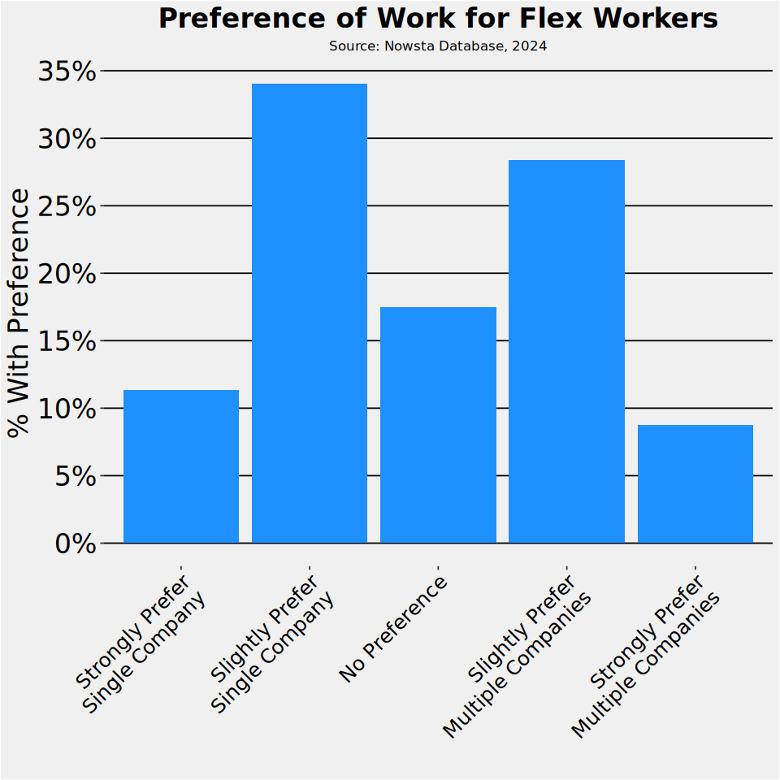According to the U.S. Bureau of Labor Statistics, an estimated 80 million workers in the United States are paid hourly, around 55% of the entire American workforce. At Nowsta, we are seeing rising trends among hourly workers in flex work; the flexibility for workers to choose when and where they work, and to not be limited to a single position. The changing dynamics of the gig economy come with challenges, but also benefits to employers who are adjusting to the flex work dynamic. In this article, we’ll explore this dynamic with what flex work looks like and the motivating factors that drive flex workers’ employment decisions.
What Does a Flex Schedule Look Like?
A flex worker’s weekly schedule can have a variety of different looks. Below is a snapshot of one particular week for 6 workers in the hospitality industry on Nowsta. As the diagram shows, there are several combinations of shifts, hours, and businesses that flex workers take on. They are also not limited to a single position or classification for tax purposes and benefits. In some cases, workers are hitting beyond full time hours by working for two or more businesses.

For many businesses that require a combination of full time and part time hourly labor, flex workers fill in seamlessly. Among Nowsta’s top 50 clients leveraging the most flex work, there is a wide distribution of flex workers’ hours per week at each business. About one quarter of flex workers are working full time with one business. The remaining shifts are filled amongst the other three-quarters of flex workers with part time schedules.

Scheduling Preferences
An effective way for flex workers to access work for multiple businesses is via staffing agencies. Agencies give workers the opportunity to take advantage of several perks of flex work that we will dive into. We conducted a survey of 450 flex workers using our platform to learn more about their employment motivations.
Being a flex worker does not have to mean you prefer flexible hours to consistent hours. In fact, this is often not the case. The below chart on the left shows the percentage of workers surveyed that indicated each preference. It turns out that few workers have a strong preference either way. However, there is an even balance between workers who slightly prefer flexible hours versus consistent hours. Note: consistent does not mean the traditional 9-5, rather just a consistent weekly schedule regardless of what the schedule is.
Similarly, flex work does not require workers to take on work for multiple companies, despite the option to. We found (from the chart below on the right) that a slight majority of workers prefer a single company, although plenty enjoy the experience of working for multiple employers.


Regardless of scheduling preference, flex workers in the gig economy are frequently seeking work opportunities, as we observe most workers are checking their gig work app – including the Nowsta worker app – daily. For some part time workers, or workers who use gig apps as a supplementary income source to another job, an occasional check-in will suffice for their preferences. Additionally, 87% of gig app users have used more than one app to look for work.

Motivations of Flex Workers
As mentioned, there are several motivating factors to flex work. The below chart shows the percentage of workers who cited each factor as highly motivating for their work preferences (other than pay). Preferences will vary from worker to worker, but we do find common factors that are meaningful to the majority of our surveyed workers.

Notably, many workers are incentivized by the opportunity to work enough hours, which correlates to total pay. Additionally, workers take pride in working for interesting businesses and at exciting events. Examples include professional sports games, concerts, banquets, and unique live experience events! Many workers also value getting paid within 2-3 business days of working an event.
Choosing a Shift
Lastly, we asked workers what motivates them when deciding between two particular shifts. Pay, exciting events, longer hours, and work environment were the top choices. While familiarity with coworkers and travel time are important, those factors more often fall lower on the list.

We can better analyze motivating factors for choosing a shift with the below chart. The heat map informs us of how each factor stacks up against the rest 1 on 1. The percent values measure how often the vertical axis factor was chosen as a higher priority than its counterpart. For example, all else equal, 29% of workers value a positive working environment to total pay. Also, only 22% of workers would prefer a short shift to a long shift.

While there are patterns that apply generally to flex workers, there is a wide spectrum of employment preferences. Businesses leveraging flex workers should look to understand the motivations of those workers in order to best retain valued talent. Additionally, they should evaluate their labor needs and seek workers whose motivations are in alignment with those needs.
Click here to see how Nowsta can help you optimize your workforce.
